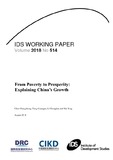From Poverty to Prosperity: Explaining China’s Growth
| dc.contributor.author | Changsheng, Chen | |
| dc.contributor.author | Guangpu, Yang | |
| dc.contributor.author | Chengjian, Li | |
| dc.contributor.author | Xing, Xin | |
| dc.coverage.spatial | China | en |
| dc.date.accessioned | 2018-08-07T15:08:26Z | |
| dc.date.available | 2018-08-07T15:08:26Z | |
| dc.date.issued | 2018-08 | |
| dc.identifier.citation | Chen, C.; Yang, G.; Li, C. and Xin, X. (2018) From Poverty to Prosperity: Explaining China’s Growth, IDS Working Paper 514, Brighton: IDS | en |
| dc.identifier.isbn | 978-1-78118-462-2 | |
| dc.identifier.issn | 2040-0209 | |
| dc.identifier.uri | https://opendocs.ids.ac.uk/opendocs/handle/20.500.12413/13987 | |
| dc.description.abstract | This paper proposes an institutional analytic framework to explain the path an economy takes from poverty to prosperity. Close examination of the development history of China since the Xinhai Revolution in 1911 under this framework indicates that it is the combination of the unbiased single-peaked governance and an access-opening economy that makes the high-speed growth of China over 40 years. Furthermore, a political economic general equilibrium model under the analytic framework is sketched and it is shown that continuous economic growth can be cultivated by either unbiased single-peaked or compromise-oriented multi-peaked political governance, as long as political cohesion and common actions can be achieved and economic accessibility is guaranteed. Based on a panel data set, we provide strong econometric evidence supporting the conjecture that a society’s cohesion can strengthen its economic growth, as can its degree of economic accessibility. But we cannot reject our third conjecture, that the single- vs multi-peaked character of political governance is a neutral variable in economic growth. | en |
| dc.description.sponsorship | UK Department for International Development | en |
| dc.language.iso | en | en |
| dc.publisher | IDS | en |
| dc.relation.ispartofseries | IDS Working Paper;514 | |
| dc.rights | This is an Open Access paper distributed under the terms of the Creative Commons Attribution 4.0 International licence (CC BY), which permits unrestricted use, distribution, and reproduction in any medium, provided the original authors and source are credited and any modifications or adaptations are indicated. http://creativecommons.org/licenses/by/4.0/legalcode | en |
| dc.rights.uri | http://creativecommons.org/licenses/by/4.0/ | en |
| dc.subject | Economic Development | en |
| dc.subject | Governance | en |
| dc.subject | Politics and Power | en |
| dc.subject | Poverty | en |
| dc.title | From Poverty to Prosperity: Explaining China’s Growth | en |
| dc.type | IDS Working Paper | en |
| dc.rights.holder | IDS | en |
| dc.identifier.team | Business, Markets and the State | en |
| rioxxterms.funder | Default funder | en |
| rioxxterms.identifier.project | Default project | en |
| rioxxterms.version | VoR | en |
| rioxxterms.funder.project | 9ce4e4dc-26e9-4d78-96e9-15e4dcac0642 | en |
Files in this item
This item appears in the following Collection(s)
-
IDS Research [1671]
Except where otherwise noted, this item's license is described as This is an Open Access paper distributed under the terms of the Creative Commons Attribution 4.0 International licence (CC BY), which permits unrestricted use, distribution, and reproduction in any medium, provided the original authors and source are credited and any modifications or adaptations are indicated. http://creativecommons.org/licenses/by/4.0/legalcode


